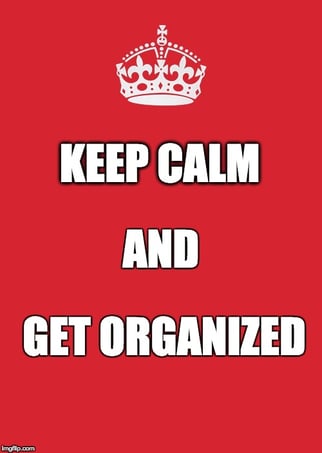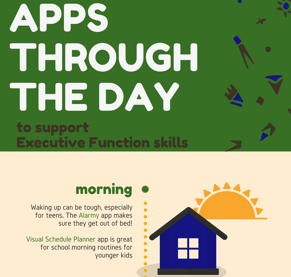At this point in the school year, students and parents have often (mostly) overcome the initial back  to school transition glitches. The class schedule is starting to feel more automatic, you know the teachers’ names, and thoughts turn more readily to fall and winter holidays than the wistful memories of sunny beach outings.
to school transition glitches. The class schedule is starting to feel more automatic, you know the teachers’ names, and thoughts turn more readily to fall and winter holidays than the wistful memories of sunny beach outings.
Yet, as soon as you think things have settled down, life gets chaotic all over again. Have you noticed that loose papers are rapidly accumulating, expensive supplies have gone missing, and that backpack seems suspiciously bloated? This is the perfect time to keep calm and teach organizational skills to your child to regain some of that back-to-school freshness and orderliness.
Organizing a Workstation at Home
Teaching organizational skills to your child can begin with instructing him or her how to get organized at home.- Designate a separate and quiet work area at home. Make sure there’s a desk or tabletop with good lighting and comfortable seating (or a large exercise ball for kids who need to fidget, such as children with ADHD).
- Hang up the school schedule and a small whiteboard or bulletin board for posting reminders.
- Use and label bookshelves as well as see-through plastic jars, bins, or stackable drawers for storage. This makes stored materials easy to locate when they’re needed.
- Use In and Out homework trays to track new and completed assignments.
- Have a 3-tier organizer for things in-progress, to do later, and file away.
Organizing Backpacks
- It’s best to start with a durable backpack with enough zipper compartments so that everything can have an assigned pocket. Things are less likely to get lost if they are always kept in the same place. For example, pens should always be kept in the same front pocket for quick and easy access.
- Create a backpack checklist to keep the backpack organized. The checklist describes each compartment and assigns each space a purpose. Photos are great for this!
- Prepare the backpack the night before and station it by the front door for school the next morning to minimize frantic morning searches.
- Sort through and clean out the backpack and its contents at least once a week. This will prevent loose papers and old snacks from collecting and provide you the heads up when you need to replenish supplies of pens or paper (before it becomes an emergency).
Organizing Homework
Every student has homework assignments on a regular basis throughout the school year. This is the perfect opportunity to teach organizational skills to your child. You can even point out that being organized will save them valuable time, allowing them to spend more time doing something more enjoyable than homework.- Use a weekly homework planner and update it consistently. Highlight important due dates in a noticeable color, and cross off assignments as they are completed. An important tip for making planners work well for a student is to write “no homework” when nothing is due the next day rather than leave a subject blank. Why? It’s a great double-check strategy - when students actively note “no homework” days, they are both reminding themselves that they checked and teaching themselves that a blank space in their planner needs further investigation.
- Use a paper clip, binder clip, or personalized bookmark to mark the page or week inside the planner so it’s easy to flip to in a hurry.
- Use an app like myHomework in lieu of a hard copy planner, which is a free application compatible with Mac, Android, and Microsoft Windows devices. It easily tracks and schedules due date reminders for classes, assignments, and tests. The app syncs between devices so classes and assignments can be accessed anytime and anywhere.
- Have an expandable 7-pocket file folder or accordion folder divided by subject for all homework. Keeping all homework in one folder divided by subject makes it easier to remember and carry between classes or to and from school.
- Try the 30/30 app when it comes to planning, prioritizing, and time management for homework. The 30/30 app is a user friendly, fully customizable task manager that allows students to label, color code, time, and save their task lists to get their work done and enjoy set breaks as needed.
Organizing School Supplies
- Use a 5 subject notebook and binders with tabs to consolidate course notes when allowed.
- Color code supplies by subject. For example, make the composition book, folder, and binder for class X all red. Textbooks can also be color coded using book sock covers. Color coding makes supplies easy to track and sort. It’s an especially helpful strategy when there’s an extensive supply list or your child is using a locker and transitioning between classrooms.
- Label all binders, notebooks, and folders with their respective subject. Add the student’s name and homeroom to the inside flap of everything so it can be returned if it’s ever lost.
Teaching Your Child Organizational Skills: Keep a Regular Maintenance Schedule
Students who learn organizational skills are equipped to perform better in school. Just like you need to maintain your house and your health with regular attention, students also need to maintain their organizational systems on a regular basis. Some kids do well with a Sunday evening clean out of folders and backpacks to ready them for the week; others prefer a daily maintenance habit. Either way, a regularly scheduled, structured expectation for organizing belongings and spaces can go a long way toward helping your child develop solid organizational skills that will set them up for success in the classroom and throughout their lifetime.
If you know a child who could use help developing their organization skills, it's likely he or she would benefit from Executive Function coaching. Click the link in blue to the left to get a free consultation today!
Download our infographic, Apps Through the Day for Students, featuring 8 of our coaches' favorite apps for helping students be more organized, focused, and productive.


